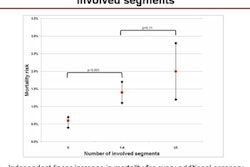Does the presence of heavy calcification hinder diagnosis with coronary CT angiography (CCTA)? It surely does, and the more calcium per segment, the greater the inaccuracy, concludes a study in the October issue of Radiology that analyzed data from the recent Coronary Artery Evaluation Using 64-Row Multidetector Computed Tomography Angiography (CORE 64) study.
In a new analysis of the multinational CORE 64 trial results, researchers from Johns Hopkins University, with the participation of several other centers, found that patients who underwent both quantitative coronary angiography (QCA) and CCTA had wide discrepancies in the results in coronary artery segments that were highly calcified. The findings led researchers to conclude that the presence of calcification reduced the diagnostic accuracy of coronary CTA on a per-segment level.
"In a symptomatic patient population, segment-based coronary artery calcification significantly decreased agreement between multidetector CT angiography and QCA to detect a coronary stenosis of at least 50%," wrote Andrea Vavere, Dr. Armin Arbab-Zadeh, and colleagues (Radiology, October 2011, Vol. 261:1, pp. 100-108).
The effect of calcification on the diagnostic accuracy of MDCT is less straightforward than it might seem. Prior studies have shown that MDCT overestimates the degree of obstructive disease when calcification is present; the phenomenon of blooming artifacts is well known.
Still, a prior subanalysis of CORE 64 data found that coronary calcium as quantified by Agatston score was not associated with reduced MDCT accuracy compared to conventional coronary angiography (CCA) in patient-based analyses. Per vessel, however, the presence of calcium was associated with reduced MDCT accuracy. And to date, the comparative diagnostic accuracy of CCA versus MDCT in a segment-based analysis has not been examined, the authors wrote.
The original CORE 64 trial examined 371 symptomatic patients (279 men, 92 women; median age, 61 years) with suspected coronary artery disease who were referred for coronary angiography, which occurred no more than 30 days following coronary CTA.
In their analysis of the CORE 64 data, Vavere and colleagues aimed to evaluate the influence of segment-level coronary artery calcification on the diagnostic accuracy of MDCT angiography compared to CCA.
Imaging began with a calcium scoring scan, followed by CCTA images acquired at 120 kV and 240 mAs to 400 mAs. The team administered iodinated contrast media (Isovue 370, Bracco Diagnostics) with images acquired using 64 × 0.5-mm high-detection CTA (Toshiba America Medical Systems). Beta-blockers were given to those with heart rates greater than 70 beats per minute (bpm), and sublingual nitroglycerin was given to those with systolic blood pressure greater than 110 mm Hg.
Two independent, blinded readers examined the percentage of diameter stenosis and the circumferential extent of calcium (arc calcium), rated per segment as mild (< 90°) moderate (90°-180°), or severe (> 180°) calcification. Clinically significant (≥ 50%) cases were evaluated using CCA. The authors used univariable and multivariable logistic regression, receiver operator characteristics (ROC) curve, and clustering methods for statistical analysis, Vavere and colleagues wrote.
Results
In all, 1,099 segments had mild calcification, 503 had moderate calcification, 338 had severe calcification, and 2,571 had no calcium. Calcified segments were highly associated (p < 0.001) with disagreement between CCTA and CCA in multivariable analysis after controlling for sex, age, heart rate, and image quality.
"As the degree of coronary calcification increased, the sensitivity of multidetector CT angiography increased" in quantities ranging from 44% in noncalcified segments to 81% in segments with severe calcification (p = 0.014), Vavere and colleagues reported. However, as the degree of calcification increased, the specificity of MDCT fell in a range from 99% in noncalcified segments to 71% in segments with severe calcification (p = 0.010). The prevalence of coronary artery disease (CAD) was 5.4% in noncalcified segments, 15% in mildly calcified segments, 27% in moderately calcified segments, and 43% in severely calcified segments, the authors wrote.
The researchers computed the diagnostic power of MDCT by calculating the area under the curve (AUC), which ranged from 0.86 (95% confidence interval [CI]: 0.82-0.90) for noncalcified segments to 0.81 (95% CI: 0.76-0.85) for severely calcified segments.
There was a significant difference between noncalcified segments and segments with varying degrees of calcification (p < 0.05); the difference in AUC was 0.01 (95% CI: 0.01-0.01) between noncalcified and mildly calcified segments, 0.04 (95% CI: 0.04-0.04) between noncalcified and moderately calcified segments, and 0.06 (95% CI: 0.05-0.06) between noncalcified and severely calcified segments.
The negative effects of calcification showed themselves in other ways as well. Among the false-positive findings at MDCT, for example, some degree of calcification was present in 85%. Among segments with false-negative findings, 37% were noncalcified and 63% had some calcification. On the other hand, among segments with true-negative results, 5% had severe calcification, 9% had moderate calcification, 24% had mild calcification, and 62% were noncalcified.
"Eighty-six percent ... of the noncalcified segments were of good-to-adequate image quality, while 54% ... of the segments with poor image quality had some degree of calcification," they wrote.
"In our study, coronary artery calcification was associated with reduced diagnostic accuracy as assessed with the AUC, specificity, and negative predictive value in a segment-based analysis," the authors wrote. "The prevalence of disease in the noncalcified group was 5% as compared with 43% in the severe calcium group."
Importantly, there were differences in the diagnostic performance of MDCT angiography based on AUCs between noncalcified segments and mildly, moderately, and severely calcified segments, they noted.
New reconstruction algorithms have been developed to address beam-hardening artifacts and maximize spatial resolution, and new technologies such as fast-switching dual-voltage technology and high-definition CT are contributing to better spatial resolution and fewer artifacts, the authors noted.
"The clinical utility of multidetector CT angiography to identify a patient with obstructive CAD has been shown by CORE 64 and other studies; however, its utility to determine the presence or absence of substantial CAD in a segment is limited by the presence and extent of coronary artery calcification," the group concluded. The authors cited potential interpretation bias and subjectivity as a study limitation.




















